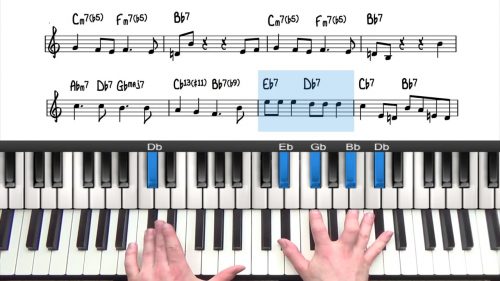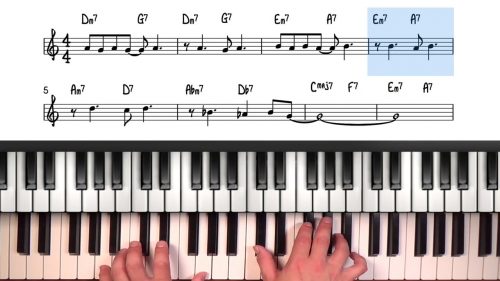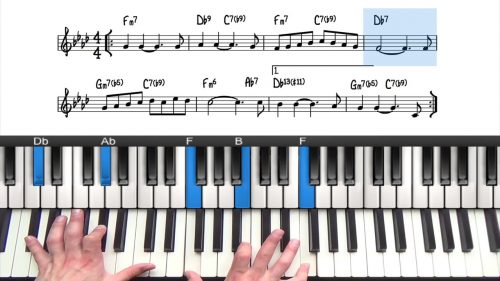In A Sentimental Mood Tutorial Part 2
Welcome to part 2 of this tutorial on Duke Ellington’s ‘In A Sentimental Mood’.
We start by introducing some bigger voicings to create a richer harmonic palate. We cover some interesting examples of altered harmony and upper structures.
In A Sentimental Mood B Section
In the bridge we will then add a simple stride style with the root played in the lower registers and rootless voicings in our left hand. The bridge features some interesting chords, we have 3 back-to-back altered dominant chords which we explore with upper structure harmony. To end the bridge we have a 13sus chord to lead us back into the final A section.
In A Sentimental Mood Melodic Embellishment
Finally we will look at ways we can embellish the melody and finish by revisiting the theory on the minor line cliche and the inner voice movement from minor 7th to major 7th to minor 6th.
Practice Tips
-
This tune has been widely recorded and there are many brilliant solo piano versions to take inspiration from.
-
Listen to jazz everyday to help you absorb the feel and articulation of the music.







Hi Hayden, this is a very informative lesson — thanks ! Could you explain why in the C13( sus4) chord, you refer to the F as a 4th, rather than an 11th ? There is a b7 in the left hand, and the F is above that, so I thought it would be an 11th. Thanks for your help.
Hi Natasha,
Good question… here’s an explanation for you:
In a sus chord, the 4th generally replaces the 3rd. When you have the 4th and the b7 together, it then becomes a sus chord, not a regular dominant chord anymore.
It’s important to note that you would never play a natural 11 in a dominant chord, just the #11. The possible upper extensions and alterations over a dominant chord are: b9, natural 9, #9, #11, & #5/b13. They are the only ones… never natural 11.
This is because the 4th/11th is an ‘avoid note’ over a dominant chord because it’s only a half step away from the 3rd and this half step creates a very dissonant interval. This is why the 3rd is generally omitted in sus chords.
Most of the time when I play sus chords, I will resolve the suspension to the 3rd after playing the sus chord… for example, I will play C13sus to a C7alt of some kind. Here, the sus chord functions as a ‘temporary stepping stone’ or ‘passing chord’: check out this lesson for more information: pianogroove.com/jazz-piano-lessons/understanding-sus-chords/
In the example you highlight in this tune, I don’t resolve the suspension which is also fine…. You don’t have to resolve the suspension in jazz, and in fact it’s sometimes nice to keep the suspension for it’s ‘floating quality’.
Herbie Hancock’s tune “Maiden Voyage” is composed entirely of sus chords that never resolve – a unique and pioneering tune of it’s time!
Hope this helps… check out the lesson referenced above which should help explain. Suspended harmony is tricky to understand at first but once it clicks it will make perfect sense.
Cheers!
Hayden
Hi, thanks for another great lesson. I’ve noticed you often put the root on the down beat and bring the rest of the chord in later in the bar. Is there a lesson where you talk about this concept?
Thanks
Hi Kester 👋
Glad you enjoyed the lesson and good question.
I don’t think there is a lesson where I discuss this concept but I can certainly give you some explanation:
As jazz musicians we have a lot of freedom in the way we play our voicings. If played all of the notes of the chord together for every chord in the tune, our playing would sound very predictable and repetitive.
As you correctly point out, sometimes i will play the root, and then fill in the rest of the notes afterwards. This is particularly useful when there is a lot of space in the harmony ie. one chord for a whole bar for example.
We could also do the opposite which would be to play the 3rd and 7th in our left hand, and then play the root afterwards. These kind of things are useful to add more interest and movement to our arrangements.
The best way to learn this stuff is to watch more of the jazz standard lessons and you will see me doing it in many different situations.
Also listen to some solo piano of say Bill Evans or Keith Jarrett and listen to how they voice their chords. You will hear that they play their voicings in many different ways and not just playing all of the notes at the same time.
Some other related lessons which I think you will enjoy:
Inner Voice Movement: pianogroove.com/jazz-piano-lessons/adding-inner-voice-movement/
Sus Chords: pianogroove.com/jazz-piano-lessons/understanding-sus-chords/
Hope this helps!
Hayden
Thanks for the reply!
Great lesson! I have the sing down except for that one Ab that leads in to the bridge! Any suggestions? Especially transitioning to any B section
wow… i’ve come watching all of these extended voicings without even completing one from Beginner Jazz Arrangements. i just wanted to see what lies ahead in my journey and honestly i’ve enjoyed them.
i’m not sure if I was looking for motivation or seeking for something unknown to me as a beginner.
is this normal in learning jazz? not advisable to jump between lessons?
anyway, i plan now to go back and practice the fundamentals.
Hi Dan,
If you like a particular tune such as this one, by all means get stuck into it. My view is that we should always be ‘getting our toes wet’ in more advanced theory. This is how we progress.
The nice thing about the beginner arrangements is that we stick just to roots, 3rds, and 7ths, in our voicings, and so it really focuses us to see the voice leading of b7ths dropping to 3rds in 251 progressions.
This really is the foundation of the harmony, and these ‘essential chord tones’ and voice leading will always be present and so being able to clearly visualise this is an important skill.
That being said I do encourage students to get stuck into the more advanced arrangements. If some of the theory doesn’t make sense right now, don’t worry about it, the full understanding will come with time.
I personally found that by pushing myself to learn more advanced voicings and arranging techniques, it inspired and motivated me to want to learn more.
So yes I would say it’s fine to jump between lessons, but make sure that you are revisiting the foundational material.
Perhaps alternate the practice plans on different days, for example 1 day on our Foundations Plan, the 2 days on the Chord Extensions plan. Find the plans here: pianogroove.com/community/c/practice-inspiration/practice-plans/21
Each practice plan is broken down into a 1 hour slot, 30 mins on the theory drills, and then 30 mins on the jazz standards in the course.
If you can do 2 hours a day I guarantee you will see rapid improvement. I found that 1 hour in the morning and 1 at night was particularly effective.
Let me know if you have any other questions Dan.
Cheers,
Hayden
Thanks Hayden. I’ll definitely check out these cheat sheet practice plans.
Hello! Would you have a pdf of this arrangement?
Hi Sylvie,
Yes I can definitely create one. It seems like this tutorial slipped through the net. Leave that with me.
You might also like to check out this lesson where we explore block chords over the opening motif of this song: pianogroove.com/jazz-piano-lessons/harmonising-step-wise-melodies/
I’m also covering this tune in a live seminar later this month, you can add to your calendar here: pianogroove.com/live-seminars/sentimental-mood-jazz-standard/
We will be covering some more advanced theory and lots of cool tips and tricks.
Hope to see you there!
Cheers,
Hayden
Did you ever do a pdf of the arrangement as Sylvia asked? I’d enjoy seeing it too.
Gib
Hi Gilbert,
Apologies the transcription still has not been completed but I have added it to my to-do-list.
I would like to create a full course around this tune, similar to the course that we have on the tune “Georgia On My Mind” – pianogroove.com/jazz-piano-lessons/bluesy-stride-piano-beginners/
I think this would be a nice tune to study in detail.
Cheers,
Hayden
Hello Hayden,
Thank you very much, I will certainly follow your recommendations, though successions of block chords seem quite advanced at this point- but remain an objective.
Sentimental Mood is such a beautiful tune, and I came across this:
Really worth listening. Discovering Michel Petrucciani, so musical and creative, quite unique
Thanks for sharing that Sylvie.
My pleasure Calvin.
Lately been listening to Emmet Cohen- you might like this:
And some more on YouTube series « Live at Emmet’s Place”
Best wishes,
Sylvie
I love it!!! Thank you.
These lessons are so clear and helpful. Thank you, Hayden!
Gib
Thanks Gilbert – I’m glad you enjoyed the lesson!
Hayden, a great lesson, as always.
In voicing this tune, you mention using a minor triad as an upper structure. Your lessons in upper structures are very clear but focus on the 4 commonly used major triads in dominant chords.
Do you have a specific lesson on minor triads as upper structures, off what scale degrees and over what kind of chords (major/minor/dominant) they are commonly used?
Many thanks.
Hi Jeremy,
Thanks for the message and I’m glad you enjoyed the lesson.
Reviewing the lesson I see that I do play a minor UST for the ascending melody in the B Section.
If I’m honest I can’t think of any other time that I have used this voicing. In this case it does work with the melody which is a somewhat unusual melody and unique to this tune.
Usually when I see the #5 in the melody, I would play a #5#9 UST (major triad off the #5) but in this case I didn’t really like how it sounded.
Another option for this section would be to play the shell in the left hand (root and b7) and then the 3rd and #5th in the right hand. I like that much more.
This is actually similar to the minor UST voicing I play, but when voiced as above, it doesn’t include the b9 as the lowest note in the right hand minor triad.
To more specifically answer your question, it is possible to create UST voicings with minor triads, and also diminished and augmented triads, but I must be honest that I don’t use these in my playing – except in this lesson! – and I haven’t explored them.
I find that the 4 major triads provide more than enough voicing colors and textural possibilities, as these 4 USTs cover almost every note that we can find over a dominant chord (root, b9, 9, #9, 3, #11, #5/b13, 13, and b7) the only tones missing here are the 5th, and the natural 7th.
If you like the sound of the UST voicing that I covered in this lesson (minor triad off the b9) then by all means take it around all 12 keys. The important thing is to remember that this can be used on dominant chords with the b9, 3, and #5 in the melody.
I don’t have any plans to create more UST lessons on minor/diminished/augmented triads. In my opinion the major triads offer more than enough options and so I wouldn’t want to ‘dilute the focus’ of this course on learning these 4 USTs in all 12 keys.
I hope that helps to answer your question.
We do have a lesson on major and minor upper structures here: pianogroove.com/jazz-piano-lessons/major-minor-upper-structures/ – and there is a cheat sheet included which has some formulas that include minor triads, but not for dominant chord qualities.
The major triad off the 9th works for both dominant 13#11, and major13#11 chords, the only difference is the b7 or natural 7th in the left hand, and so I find that to be an important relationship to understand.
Please let me know if you have any other questions here.
Talk soon,
Hayden
I’m sorry for the delay in replying. I am glad you don’t have any plans to create more UST lessons on minor or other triads. It’s reassuring to learn that the 4 USTs that you have presented so clearly and use in many of your excellent lessons are enough to get under my hands.
My pleasure Jeremy and no problem with the late reply.
Yes… learn those 3 USTs inside out, apply to lots of tunes, recite the scale formulas away from the piano, and try to apply them to any dominant chord on any lead sheet.
As mentioned, there are only 2 notes over a dominant chord where those 4 formulas don’t work (the 5th and the major 7th) and so those 4 formulas will have you covered!
Happy Holidays!
Talk soon,
Hayden